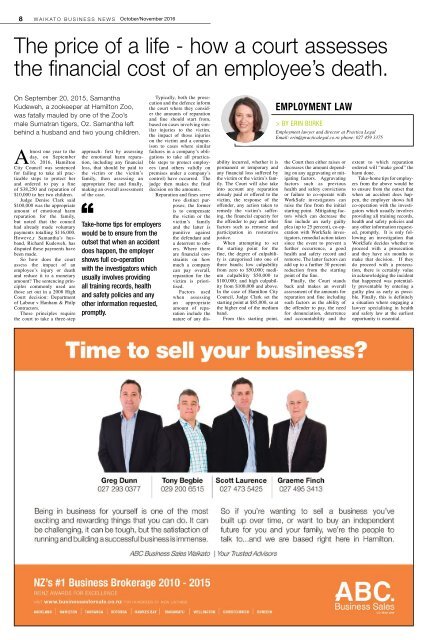Waikato Business News October/November 2016
Waikato Business News has for a quarter of a century been the voice of the region’s business community, a business community with a very real commitment to innovation and an ethos of co-operation.
Waikato Business News has for a quarter of a century been the
voice of the region’s business community, a business community
with a very real commitment to innovation and an ethos of
co-operation.
You also want an ePaper? Increase the reach of your titles
YUMPU automatically turns print PDFs into web optimized ePapers that Google loves.
8 WAIKATO BUSINESS NEWS <strong>October</strong>/<strong>November</strong> <strong>2016</strong><br />
The price of a life - how a court assesses<br />
the financial cost of an employee’s death.<br />
On September 20, 2015, Samantha<br />
Kudeweh, a zookeeper at Hamilton Zoo,<br />
was fatally mauled by one of the Zoo’s<br />
male Sumatran tigers, Oz. Samantha left<br />
behind a husband and two young children.<br />
Almost one year to the<br />
day, on September<br />
16, <strong>2016</strong>, Hamilton<br />
City Council was sentenced<br />
for failing to take all practicable<br />
steps to protect her<br />
and ordered to pay a fine<br />
of $38,250 and reparation of<br />
$10,000 to her two children.<br />
Judge Denise Clark said<br />
$100,000 was the appropriate<br />
amount of emotional harm<br />
reparation for the family,<br />
but noted that the council<br />
had already made voluntary<br />
payments totalling $116,000.<br />
Howeve,r Samantha’s husband,<br />
Richard Kudeweh, has<br />
disputed these payments have<br />
been made.<br />
So how does the court<br />
assess the impact of an<br />
employee’s injury or death<br />
and reduce it to a monetary<br />
amount? The sentencing principles<br />
commonly used are<br />
those set out in a 2008 High<br />
Court decision: Department<br />
of Labour v Hanham & Philp<br />
Contractors.<br />
These principles require<br />
the court to take a three-step<br />
approach: first by assessing<br />
the emotional harm reparation,<br />
including any financial<br />
loss, that should be paid to<br />
the victim or the victim’s<br />
family, then assessing an<br />
appropriate fine and finally,<br />
making an overall assessment<br />
of the case.<br />
Take-home tips for employers<br />
would be to ensure from the<br />
outset that when an accident<br />
does happen, the employer<br />
shows full co-operation<br />
with the investigators which<br />
usually involves providing<br />
all training records, health<br />
and safety policies and any<br />
other information requested,<br />
promptly.<br />
Typically, both the prosecution<br />
and the defence inform<br />
the court where they consider<br />
the amounts of reparation<br />
and fine should start from,<br />
based on cases involving similar<br />
injuries to the victim,<br />
the impact of those injuries<br />
on the victim and a comparison<br />
to cases where similar<br />
failures in a company’s obligations<br />
to take all practicable<br />
steps to protect employees<br />
(and others validly on<br />
premises under a company’s<br />
control) have occurred. The<br />
judge then makes the final<br />
decision on the amounts.<br />
Reparation and fines serve<br />
two distinct purposes;<br />
the former<br />
is to compensate<br />
the victim or the<br />
victim’s family<br />
and the latter is<br />
punitive against<br />
the defendant and<br />
a deterrent to others.<br />
Where there<br />
are financial constraints<br />
on how<br />
much a company<br />
can pay overall,<br />
reparation for the<br />
victim is prioritised.<br />
Factors used<br />
when assessing<br />
an appropriate<br />
amount of reparation<br />
include the<br />
nature of any disability<br />
incurred, whether it is<br />
permanent or temporary and<br />
any financial loss suffered by<br />
the victim or the victim’s family.<br />
The Court will also take<br />
into account any reparation<br />
already paid or offered to the<br />
victim, the response of the<br />
offender, any action taken to<br />
remedy the victim’s suffering,<br />
the financial capacity for<br />
the offender to pay and other<br />
factors such as remorse and<br />
participation in restorative<br />
justice.<br />
When attempting to set<br />
the starting point for the<br />
fine, the degree of culpability<br />
is categorised into one of<br />
three bands; low culpability<br />
from zero to $50,000; medium<br />
culpability $50,000 to<br />
$100,000; and high culpability<br />
from $100,000 and above.<br />
In the case of Hamilton City<br />
Council, Judge Clark set the<br />
starting point at $85,000, so at<br />
the higher end of the medium<br />
band.<br />
From this starting point,<br />
EMPLOYMENT LAW<br />
> BY ERIN BURKE<br />
Employment lawyer and director at Practica Legal<br />
Email: erin@practicalegal.co.nz phone: 027 459 3375<br />
the Court then either raises or<br />
decreases the amount depending<br />
on any aggravating or mitigating<br />
factors. Aggravating<br />
factors such as previous<br />
health and safety convictions<br />
or failure to co-operate with<br />
WorkSafe investigators can<br />
raise the fine from the initial<br />
starting point. Mitigating factors<br />
which can decrease the<br />
fine include an early guilty<br />
plea (up to 25 percent), co-operation<br />
with WorkSafe investigators,<br />
remedial action taken<br />
since the event to prevent a<br />
further occurrence, a good<br />
health and safety record and<br />
remorse. The latter factors can<br />
add up to a further 30 percent<br />
reduction from the starting<br />
point of the fine.<br />
Finally, the Court stands<br />
back and makes an overall<br />
assessment of the amounts for<br />
reparation and fine including<br />
such factors as the ability of<br />
the offender to pay, the need<br />
for denunciation, deterrence<br />
and accountability and the<br />
extent to which reparation<br />
ordered will “make good” the<br />
harm done.<br />
Take-home tips for employers<br />
from the above would be<br />
to ensure from the outset that<br />
when an accident does happen,<br />
the employer shows full<br />
co-operation with the investigators<br />
which usually involves<br />
providing all training records,<br />
health and safety policies and<br />
any other information requested,<br />
promptly. It is only following<br />
an investigation that<br />
WorkSafe decides whether to<br />
proceed with a prosecution<br />
and they have six months to<br />
make that decision. If they<br />
do proceed with a prosecution,<br />
there is certainly value<br />
in acknowledging the incident<br />
that happened was potentially<br />
preventable by entering a<br />
guilty plea as early as possible.<br />
Finally, this is definitely<br />
a situation where engaging a<br />
lawyer specialising in health<br />
and safety law at the earliest<br />
opportunity is essential.


















